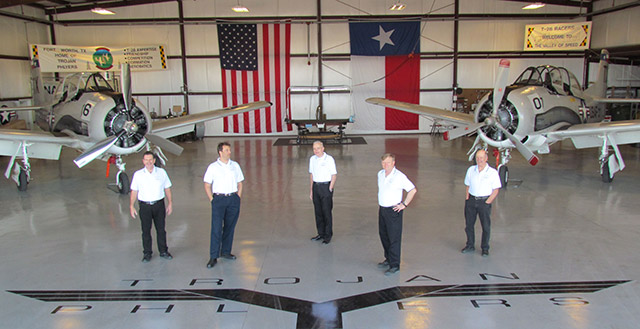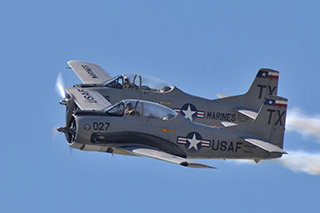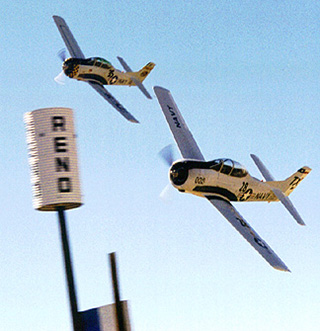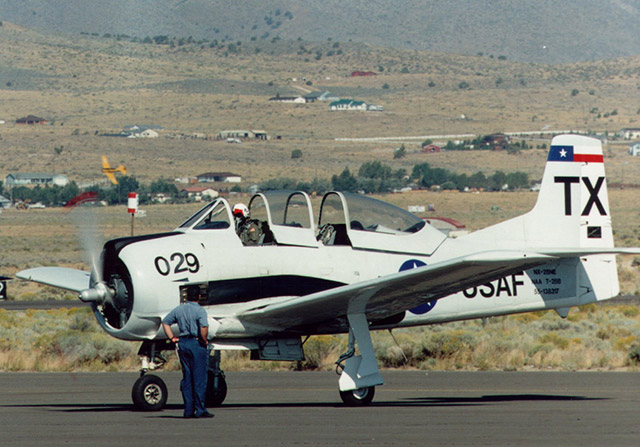
The Trojan Phlyers is like no other flying club in the world. That’s in part because it’s not actually a club. It’s a subchapter S corporation with eight partners that own two North American T-28Bs.
While the organization may be a little different, the operating dynamics are very similar to most flying clubs. For about 25 years, the group has been providing an opportunity for pilots to fly Warbirds at a fraction of the cost of ownership in a way that could serve as a model for anyone who wants to form a club to fly big, loud, historic aircraft that are economically out of reach for most people.
 “What we do is we give guys a chance to fly a Warbird at a reasonable cost and if you want to get checked out as an air show pilot, we can do that too,” Trojan Phlyers President Chip Lamb said.
“What we do is we give guys a chance to fly a Warbird at a reasonable cost and if you want to get checked out as an air show pilot, we can do that too,” Trojan Phlyers President Chip Lamb said.
Originally the group intended to buy several T-28s that were boxed up in parts, put them together and sell them for profit. That was in the early ‘90s, but what ended up happening was the price of T-28s dropped to the point where the group had invested more in the aircraft than they were likely to get back. “The intent was to fly them until the market recovered,” Chip said. “Well the market hasn’t really recovered.”
That’s because the nine-cylinder Wright Cyclone R1820-86B radial engine that powers the former Navy trainer burns 100 gallons per hour. So as the price of gasoline goes up, the price of the airplanes goes down. To buy a T-28 today, prices range from about $125,000 to $225,000.
The T-28 was designed after World War II as the successor to the T-6, with the first model, the 800-hp T-28A, going into service in the U.S. Air Force in 1950. The Navy versions, the T-28B and T-28C models, had the 1425-hp R-1820 and were in service from 1955 until 1984. The aircraft can takeoff in less than 800 feet, climb to 10,000 feet in less than 90 seconds, reach 335 mph in level flight, and dive faster than 380 mph. According to the Trojan Phlyers web site, the T-28 can outperform most World War II fighters at low altitude. The group’s two aircraft were originally primary trainers in the Navy.
The Trojan Phlyers decided if they weren’t going to sell the aircraft they should have some fun with them. About 15 years ago they started flying air shows to help defray the costs, and they even raced at Reno when there was a T-28 class.
Most of the air shows they participate in are located within a few hundred miles of their base at Mid-Way Regional Airport (KJWY), just south of downtown Dallas and southeast of downtown Fort Worth, Texas.
 Chip flew F-4s and F-16s in the US Air Force and Air National Guard. When he retired he wanted to fly World War II fighters, like the P-47 Thunderbolt. He joined the Commemorative Air Force and was told the path to the cockpit of one of their fighters starts with 200 hours of time in a North American T-6 Texan.
Chip flew F-4s and F-16s in the US Air Force and Air National Guard. When he retired he wanted to fly World War II fighters, like the P-47 Thunderbolt. He joined the Commemorative Air Force and was told the path to the cockpit of one of their fighters starts with 200 hours of time in a North American T-6 Texan.
That created a bit of dilemma for Chip. His total time in a T-6 was exactly 0 hours. He learned to fly in a taildragger in the 1970s, but hadn’t flown tailwheel in decades. So what could he do? One option was to buy a T-6, find an instructor and learn how to fly it. Add in the insurance, maintenance and hangar costs and it gets expensive.
That’s when he found the Trojan Phlyers at an air show. “I walked up to where the airplanes were and talked to one of the gentleman with the group,” Chip said. “I said I was interested in learning and joining the group and he said, ‘Let’s go fly,’ and put me in the front seat. We blasted off and by the time we got the gear up I said, ‘This is what I want to do. This is cool.’”
Not only was it fun, it was much more affordable then buying his own T-6. A share of the corporation costs $25,000 and members pay an assessment that is generally between $3,000 and $4,000 a year for fixed costs such as insurance, hangar rental, and the annual for both aircraft. Members pay $300 an hour wet to fly the aircraft, which is less than the actual operating costs for gas and oil.
“When I found out about this group in 2000, I said, ‘Let me get this straight—you’ve got multiple airplanes, the buy in is $25,000 at $300 an hour, back then it was $100 an hour, and I’ve got instructors who will teach me, I’ve got partners who will go flying with me?’ That’s a much better deal,” Chip said. “You can’t buy a pickup truck for $25,000 and in this case you get a buy-in for two different airplanes. In that sense it’s kind of like a club.”
The group has had three new members join in recent years and they can either purchase a share from the corporation or an existing member who wants to sell. There’s no limit to the number of members and anyone can join the group, but that’s not a guarantee you’ll get to fly as pilot in command. “To get a check ride you have to have what’s called an experimental rating,” Chip said. “You also have to have 500 hours of total time with 50 hours of complex time.”
One of the benefits of the Trojan Phlyers is they provide all the instruction in the airplanes and mentor new pilots. “The nice thing about us is you literally have the established organization that has standardized training, its own instructors, its own mentors, maintenance, and we even have our own hangar,” Chip said. “When I was thinking about buying a T-6, I would have been a babe in the woods. I would have known nothing about how to do that.”
The corporation is organized much like a flying club with bylaws and officers, and standardization meetings every six months. The group is too small to have a formal board of directors, but everyone is considered a board member.
And like some clubs, to encourage members to maintain currency, the Trojan Phlyers charge members for an hour of flying each month whether they fly or not—which serves as great motivation to keep members flying Chip said. In addition, they hold a formation clinic with other T-28 owners each spring to keep their skills sharp. And if you want to learn to fly aerobatics, the Trojan Phlyers can teach that as well.
“If you join and get comfortable doing aerobatics in the airplane, there is nothing to stop you from becoming one of the air show pilots,” Chip said. Currently three of the eight members fly air shows–Chip and John Sledge do a formation routine, and Hugh Grandstaff flies a solo aerobatic show. Not all of the partners want to be aerobatic pilots, but they want to fly the T-28 and they will go to the air shows and serve as ground crew members.
“What I like best is that I have the opportunity to fly multiple airplanes with the camaraderie of a small fighter squadron. We get to exercise our abilities flying aerobatics, we get to fly formation, and I get to do formation aerobatics at air shows,” Chip said. “It’s a way to continue my flying career–I’m retired from the military and retired from the airlines. It’s exciting, and it’s not a $500 hamburger.”
The Trojan Phlyers technically may not be a flying club. But if you look at how the group is organized from the cost structure to the camaraderie, you’d be hard pressed to come away thinking they are anything but a unique flying club that offers members an opportunity to fly amazing aircraft at a reasonable cost, while providing the instruction to improve their flying skills and have a lot of fun in the process. And the best part is, as Chip said: “There’s nothing that says other people can’t do this.”
|
Name |
Trojan Phlyers |
|
Location |
Mid-Way Regional Airport (KJWY), Midlothian, TX |
|
Website |
http://www.trojanphlyers.com or |
|
Year formed |
1990 |
|
Aircraft |
1953 T-28B ($300/hr) |
|
Joining fee |
$25,000 |
|
Monthly dues |
$3,000 - $4,000 annual assessment |
|
Membership |
8 |
|
Scheduler |
N/A |
